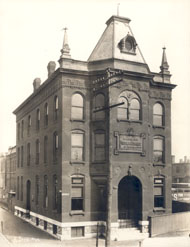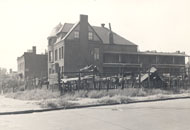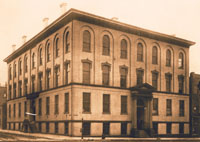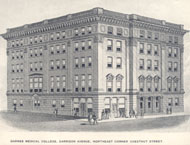Health Professions
Early Medical Education for Women in St. Louis
Though Elizabeth Blackwell, the first woman to graduate from medical school in the United States, received her medical degree in 1849, it took 25 years for a medical school in St. Louis to grant a degree to a woman student. Medical education in the second half of the 19th century was far different than that of today. Few schools had university affiliations or were connected with teaching hospitals. Schools were often owned and run for a profit by their professors. Instruction was often through lecture alone. Nineteenth century medical practice itself was divided into sects. Orthodox or regular medicine, homeopathy and eclecticism were the primary factions and often in conflict with each other.
Homeopathy came to the United States in about 1835, developed by the German physician Samuel Hahnemann. Hahnemann stressed two “laws” of homeopathy: “let likes be cured by likes” and the smaller the dose, the more effective it is in stimulating a cure. Instead of bleeding, blistering and purging, homeopathy prescribed a regimen of diet, exercise, and fresh air. The success of homeopathic treatments during the cholera epidemics of 1848-1852 increased its popularity. Eclecticism purported to combine the best of orthodox, homeopathic and other sectarian medical theories and practices.
The Homeopathic Medical College of Missouri opened in 1857 and its first class graduated in 1859. In 1874 the college began to grant degrees to women. In the early 1880s the faculty of the Homeopathic Medical College of Missouri decided that medical education should be segregated by sex because coeducation endangered a woman’s sense of modesty and purity. In the fall of 1883 a sister institution, the Women’s Medical College of St. Louis, opened. However, female students who had already matriculated at the Homeopathic Medical College were not required to transfer to the new school. When a woman, Alice B. McKibben, was elected valedictorian of the co-educational school the following spring, the argument for single-sex schools lost strength and the Women’s Medical College closed. The Homeopathic Medical College of Missouri continued in operation until 1909.
The American Medical College, an eclectic medical school founded in 1873, graduated its first woman in 1888. In 1911 the American Medical College combined with the Barnes Medical College. The following year the combined school became the Medical Department of the National University of Arts and Sciences in St. Louis. The National University then merged with the St. Louis College of Physicians and Surgeons around 1915.
The orthodox medical educational community resisted the admission of women students longer than did the homeopathic and eclectic schools. The Woman’s Medical College of St. Louis (also known as the St. Louis Woman’s Medical College) was incorporated in 1891. The college, not associated with the short-lived homeopathic college of the same name a decade earlier, was the first school west of the Mississippi exclusively for the medical education of women. The initial location was 1414 Lucas Place and the school opened in September 1892. The first class graduated in 1894. In 1893 the College occupied a building at the northeast corner of 16th and Pine Streets. The Women’s Medical College of St. Louis suspended operations in 1896 due to a lack of funds. Among the few graduates were Henrietta Borck and Ellen Osborne.
Kate Spain, a secretary on the staff of the St. Louis College of Physicians and Surgeons, received permission to attend lectures at the college in the mid-1890s, as long as they did not conflict with her secretarial duties. In 1895 the faculty allowed her to graduate. Among the other women to receive medical degrees from the St. Louis College of Physicians and Surgeons were Matilda Luke Tibe (1909), Clara Pauline Rothman Mutshnick (1909), Emma Phelan (1909), Emma Ploehn (1913), and Elva Carmain Smith (1914).
The Barnes Medical College (opened in 1892) graduated its first woman, Nevada Adams, in 1902. Adams left St. Louis to practice medicine in New Mexico, but over the next several years over a dozen women graduated from Barnes Medical College and practiced medicine in St. Louis. The graduates included Elizabeth Etta Rusk West (1904), Genevieve Stuart Beckham (1905), Pauline A. Thompson (1905), Rose Minnie Rose (1907), Oda Lavinia Seabaugh (1908), Florence Ourat Eggers (1909), Elizabeth Robenia Hempel (1909), Edna Miller Stone (1909), Lillian Van Arsdale Young (1909), and Dora Rochelle Schuyler (1910).
On the western side of the state of Missouri, the Woman’s Medical College of Kansas City opened in 1895 and graduated its first class the following year. The college was short-lived, closing in 1903. Women graduates included Addie Board-Arthur (1899) and E. Alma Lane (1902).
By the turn of the 20th century American medicine was in the midst of reform. University-based medical schools began to replace proprietary medical colleges. Orthodox medicine dominated as homeopathy was discredited and eclecticism disappeared. Some university-based medical schools, such as the University of Michigan and Johns Hopkins University, had been accepting women students for several years (1871 and 1893, respectively). Washington University admitted women for the first time in 1918. The University of Missouri-Columbia began accepting women in 1897, graduating the first woman in 1900. St. Louis University did not admit women until 1948.
Related Links:
Return to Medicine (Health Professions)
Return to Health Professions
Back to Top




